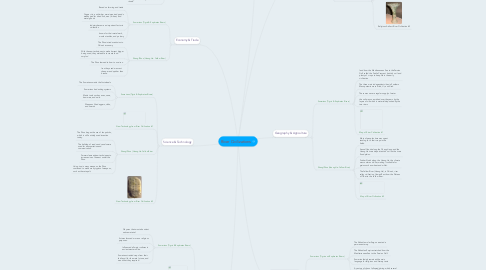
1. Social Structure & Family Life
1.1. Sumerians (Tigris & Euphrates Rivers)
1.1.1. Three major social groups.
1.1.2. Most the people were farmers due to the rich soil.
1.1.3. The Nobles included many of the royal and religious officials
1.1.4. Slaves built buildings
1.2. Shang/Zhou (Huang He: Yellow River)
1.2.1. Wealthy members of the elite activities such as hunting, and collecting objects made from jade and bronze.
1.2.2. The poor farmers would get called into battle every now and then or do labor for the kingdom.
1.2.3. Social pyramid in the Shang/Zhou society goes the king, military nobility, priests, merchants, and finally farmers.
1.2.4. Most social classes were easily distinguished through burial site and rituals.
2. Economy & Trade
2.1. Sumerians (Tigris & Euphrates Rivers)
2.1.1. Based on farming and trade
2.1.2. Copper, tin, and timber were imported goods exchanged for dried fish, wool, wheat, and metal goods
2.1.3. Industry became an important factor in civilization
2.1.4. known for their metalwork, woolen textiles, and pottery
2.2. Shang/Zhou (Huang He: Yellow River)
2.2.1. The Zhou introduced coins to China's economy.
2.2.2. With the new techniques to make harvest bigger being used, they were able to create food surplus'.
2.2.3. The Zhou learned to how to use iron.
2.2.4. Iron they used was cast cheaper and quicker than bronze.
3. Science & Technology
3.1. Sumerians (Tigris & Euphrates Rivers)
3.1.1. The Sumerians made the first wheels
3.1.2. Sumerians had writing systems
3.1.3. Made tools such as axes, saws, hammers, and nails.
3.1.4. Weapons like daggers, clubs, and swords
3.2. New Technology from River Civilization #1
3.3. Shang/Zhou (Huang He: Yellow River
3.3.1. The Zhou began the use of chopsticks, which is still a widely used invention today.
3.3.2. The building of roads and canals were used for transportation and communication.
3.3.3. Farmers learned new techniques to increase size of harvest under the Zhou.
3.3.4. Using iron in many weapons, the Zhou continued to make many types of weapons, such as the catapult.
3.4. New Technology from River Civilization #2
4. Arts & Education
4.1. Sumerians (Tigris & Euphrates Rivers)
4.1.1. Clay was their most abundant native material.
4.1.2. Art was focused more on religious purposes.
4.1.3. Influenced all major cultures in ancient western Asia.
4.1.4. Sumerians traded crops from their fertile soil for the metal, stone, and wood that they required.
4.2. Art from River Civilization #1
4.3. Shang/Zhou (Huang He: Yellow River)
4.3.1. Worked in bone, jade, ceramics, stone, wood, shells, bronze, and later iron.
4.3.2. They used bamboo strips to write books onto.
4.3.3. The domestication of animals, such as pigs, dogs, and sheep was a step in education.
4.3.4. Confucianism and Taoism were widely taught.
4.4. Art from River Civilization #2
5. Religion
5.1. Sumerians (Tigris and Euphrates Rivers)
5.1.1. Sumerians worshiped many gods, this was time of practice of Polyphemism
5.1.2. Gods controlled all natural forces.
5.1.3. A god protected each city state
5.1.4. They believed that gods were like humans in many ways.
5.1.5. Religious Artifact River Civilization #1
5.2. Shang/Zhou (Huang He: Yellow River)
5.2.1. When rulers died, hundreds of sacrificed prisoners of war were buried with the ruler.
5.2.2. Believed in some sort of afterlife
5.2.3. Centered on worship of ancestors
5.2.4. Often asked for advice from ancestors through oracle bones.
5.2.5. Religious Artifact River Civilization #2
6. Geography & Agriculture
6.1. Sumerians (Tigris & Euphrates Rivers)
6.1.1. land from the Mediterranean Sea to the Persian Gulf called the Fertile Crescent had rich soil and plenty of crops to keep life in the early civilization
6.1.2. The three main independent cities in Southern Mesopotamia were Eridu, Ur, and Urak.
6.1.3. There was never a regular supply of water
6.1.4. the soil was so enriched over the years by the layers of silt which is material deposited by the two rivers
6.1.5. Map of River Civilization #1
6.2. Shang/Zhou (Huang He: Yellow River)
6.2.1. Most of peoples time was spent tending to to their crops in the fields.
6.2.2. Annual floods along the Chang Jiang and the Huang He rivers deposited rich soil on the rivers flood plains.
6.2.3. Further North along the Huang He, the climate was cooler and drier, making it suitable for grains such as wheat and millet.
6.2.4. The Yellow River (Huang He), in China's, river valley civilization, flowed East from the Plateau of Tibet to the Yellow River.
6.2.5. Map of River Civilization #2
7. Government & Leaders
7.1. Sumerians (Tigris and Euphrates Rivers)
7.1.1. The Akkadian ruler Sargon created a permanent army.
7.1.2. The Akkadian Empire stretched from the Mediterranean Sea to the Persian Gulf.
7.1.3. Sumerian thaigh remained the main language for religious and literary texts
7.1.4. A century of chaos followed during which several tribes battled for control of Mesopotomia
7.2. Shang/Zhou (Huang He: Yellow River)
7.2.1. Ruled by a strong monarchy
7.2.2. The king appointed governors to rule distant parts of the kingdom
7.2.3. At the capital city of Anyang, Shang Kings were surrounded by a court, or wealthy nobles, who performed rituals to strengthen kingdom
7.2.4. To keep the kingdom safe, the king appointed governors to different places in China
